
An Unappreciated Italianate Delight
(written by Dr. Les Crocker, Emeritus Professor of Art History)
Beginning in the 1870s, Cass Street and West Avenue became the most exclusive neighborhood in La Crosse. The Cargill house, John Paul's house, the McMillan house, the Bunn house, the huge Easton houses further east of West Avenue, and the grand Romanesque Revival Scott house at State Street and West Avenue showed the wealth of their owners. All of these grand mansions are gone, but the most unappreciated house in La Crosse remains.
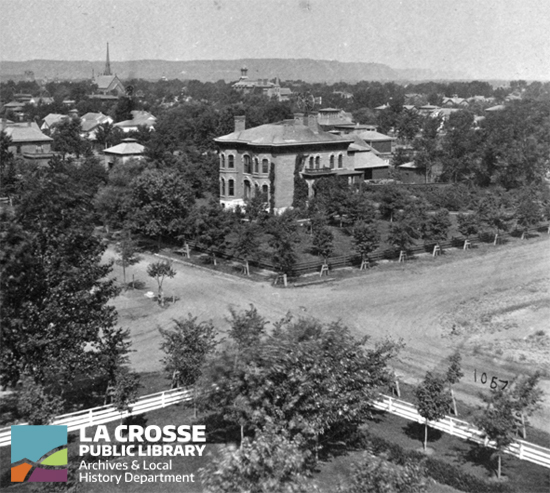
The neighborhood near Cass Street and West Avenue was the most desirable place in La Crosse to live in the 1870s. Shown above is the long ago razed John Paul mansion located at 1133 Cass Street at the northwest corner of Cass Street and West Avenue, looking northwest toward downtown and the Minnesota bluffs along the Mississippi River. Photo taken by Elmer and Tenney, circa 1880. Photo courtesy of the La Crosse Public Library Archives.
The Italianate style is a 'made up' style. The variety of styles in Italy meant that American architects and builders could call almost anything “Italianate” and most people wouldn't know the difference. In La Crosse the Italianate style brought in a major change in house plans. Early houses were usually rectangular, with a decorated front. After the Civil War the Italianate style brought in the use of 'wings,' sections of the house at a right angle to the main unit, usually on just one side, but occasionally on both.
By 1884 the Queen Anne style had appeared in La Crosse. Queen Anne houses usually had a sprawling ground plan, completely unlike the tight ground plan of the Italianate style. Mr. Vincent shows he is traditional in his choice of ground plans.

The James Vincent Family: James, daughter Agnes and Agnes. Vincent made his wealth from the lumber and millwork industry. Photo taken by Richardson, circa 1891. Photo courtesy of the La Crosse Public Library Archives.
James Vincent was a lumber dealer and like a lot of the lumbermen in La Crosse he made a fortune. The most obvious and dramatic way to proclaim your wealth was, and is, to build a mansion. Vincent built a family home in 1884-85, but a family home with delightful details. It does not awe by its size but delights with its detail. I think Vincent was a practical man who didn't want six bedrooms and three parlors, and who appreciated good design more than grandeur.
By the 1880s, it was more prestigious to hire a big city architect rather than a local one. W. L. Carroll of Chicago made a design for the Vincent house in 1879 but when it was built in 1884-85 the young, local architect William Parker made significant changes. The following discussion will make more sense if you look at the photos along with the written text. This is a complex building that requires careful study.
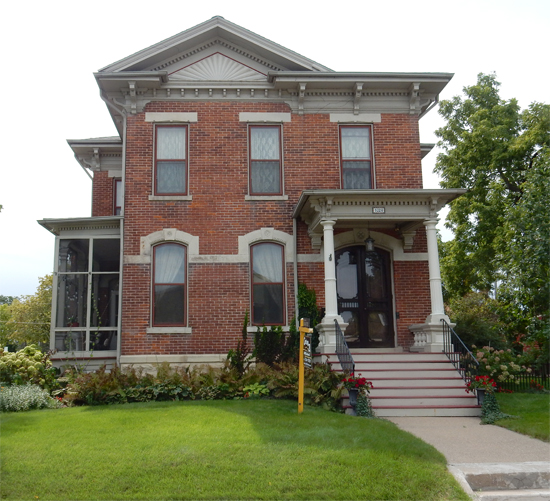
The James and Agnes Vincent House at 1024 Cass Street. Photo taken by Dr. Les Crocker, 2020.
A bay is an opening on the first floor, whether these are windows or doors. The front of the Vincent House presents itself as three-bays wide with the entrance in the bay to the west. There was a secondary entrance in the wing for family and friends that didn't want to use the formal entrance. This secondary entrance is now obscured by a screen porch probably added in the early twentieth century. The house sits on a raised basement which means there must be steps to get to the front door.
A raised basement gives a house more authority, more importance. A single-bay porch is at the top of the steps, providing cover for visitors. Most houses of this type had front porches but none as grand as the Vincent house. Two columns carry the weight of the porch roof. The capitals are pillow shaped like the very early Greek Doric columns. Beneath the capitals are a short section of fluted column, then a simple rolled molding. Beneath that, the column is plain until we reach another rolled molding, proportionately larger than the upper one. Another section of fluted column rests on a molded base. The entire column stands on four blocks to spread its supposed weight.
The blocks rest on an elaborate pedestal with a three-part molding, a section with inset panels, and a plain base. The pedestal is joined to a thick porch railing supported on vase shaped balusters that hadn't been used in American houses for over a hundred and fifty years.
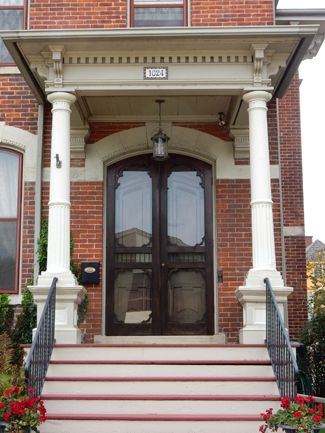
Front entrance detail. Photo taken by Dr. Les Crocker, 2020.
The columns support a cornice with a simple base molding, a plain freeze and a cornice of dental blocks. A bracket, strong in appearance but not massive, is centered over the column on two sides.

Bracket detail on a corner of the house. Photo taken by Anita Taylor Doering, 2019.
Brackets got larger and larger in the Italianate style and became a defining element of the style. While the outer end of the porch roof is supported on the two columns the house end of the porch roof is carried on two elaborate corbels extending from the brick wall. Italianate houses almost always have double leaf front doors, with panel moldings. Mr. Vincent had access to any locally grown wood that he wanted and his doors are thick with fine molding.

Looking up we see the same arrangement of forms in the roof cornice. Photo taken by Dr. Les Crocker, 2020.
The brackets are larger because the cornice is deeper, everything is in proportion. Above the two front bays, not part of the entrance, is a classical pediment with cornice returns, the horizontal sections across the bottom of the pediment but unconnected. The central section of the pediment displays a rising sun motif, unusual in the Italianate style but more common in the Queen Anne style.
The basement wall above ground is a white limestone with a rough surface. Above that is a smooth surfaced stone, a light-colored water table, a hard stone that prevents the wicking of moisture in the basement stone into the brick of the living area. It forms a continuous band around the house and visually links with the limestone window headers.
Brick walls are boring. The use of white limestone around windows and doors helped to break the monotony of the brick. The Vincent house windows have thin stone sills but the window heads are thick stone, flat, arches supported on knee blocks that rest on a band of limestone that links the two windows and the arch over the entrance. The second floor windows have limestone lintels with simple carvings on their bottom.
If we move from the Cass street side to the Eleventh street side once again we see the complexity of detail.

The side facing 11th Street. Photo taken by Dr. Les Crocker, 2020.
The main block of the house is a rectangle but an extension, called a ‘wing’ in the nineteenth century, breaks the rectangle. Not only is this wing interesting for its decoration it allows extra windows on three sides for better air circulation and is the location of the secondary, or family, entrance. This side of the house has two marvelous bay windows as well.
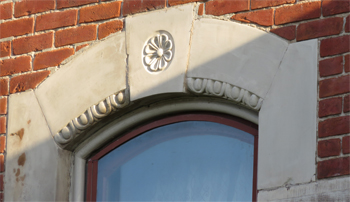
Upper window head detail. Photo taken by Anita Taylor Doering, 2019.
The sills of the bay windows form a continuous line that echoes the thicker window heads, decorated by an open flower flanked by vine like shapes on the two side window heads while the central window head has a simple egg and dart carving on its lower edge. Above the white widow heads the brickwork resumes with two courses that overhang the one below. This creates shadow lines that give the brick more definition. The overhanging brick frames two rows of terra cotta plaques with spiral motifs. Terra cotta is a red clay that is exceptionally hard when fired and allows sharp detail when carved.
Above the terra cotta the brick courses alternate their depth to vary the surface. A thin limestone band caps the top of the bay window. Above this cap are four short brick pedestals with courses of varied depth and capped with a limestone block. The pedestals are linked with some of the earliest examples of decorative ironwork remaining in the city.
The deeply over hanging eaves have large brackets for their visual support and the pediment with returns repeats the facade pediment. Small brackets and dental blocks fill the line where the cornice meets the overhanging eaves. A simpler version of the sunrise motif fills the center of the pediment.
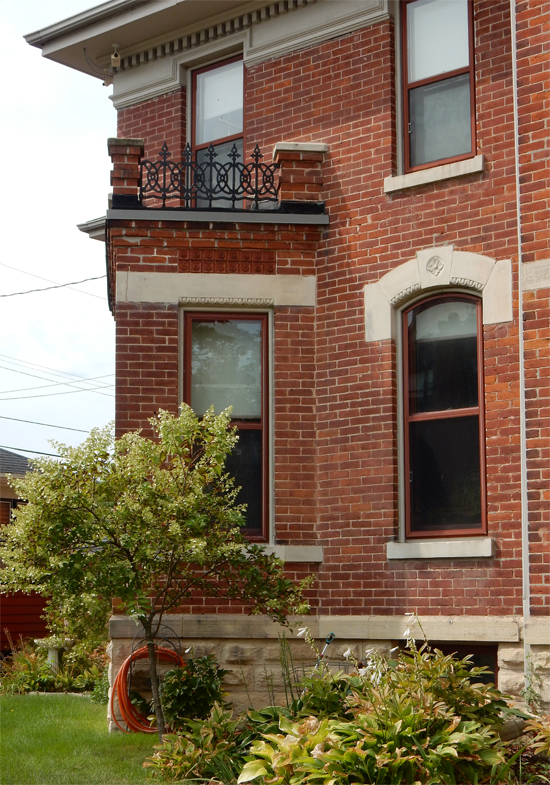
The two-sided bay window. Photo taken by Dr. Les Crocker, 2020.
Further south on this east wall is a two-sided bay window that echoes all the features of the larger, three-sided bay window but with a different design in the ironwork balustrade. These bay windows not only break the monotony of the brick wall and create better ventilation, they were great places for indoor plants which were quite popular at the time.
Our view of the world has been defined by the automobile windshield. We see straight ahead with little concern for what we pass. The world of 1884 was very different with slow moving carriages, wagons and pedestrians. Details on buildings made them unique as well as lovely. James Vincent had a house with many subtle details, and some not so subtle, like the massive pediments.
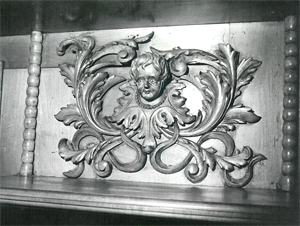
Carving detail by Ori Sorensen of the Egid Hackner Altar Company. Photo taken by Don Sutor, 1980.
On the interior he commissioned one-of-a-kind, built-in furniture with carvings done by Ori Sorensen from the Egid Hackner company. His bathroom had one of the earliest indoor toilets and the bath tub, along with the one in the Hixon house, is one of the two early examples remaining in town. But that is another story.
Today we are too busy to notice detail. Television blasts our eyes and minds with an ever-changing montage of images. The Vincent house is from a time that appreciated good proportions and delightful detail. It is a most unappreciated home.
A slightly longer version of this blog with more detail describing the Italianate style, can be found here: Unappreciated_Italianate_delight_-_long_version.pdf
